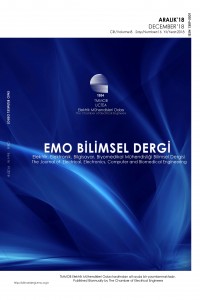Öz
Mie Theory sets basis for more advanced applications in
scattering by presenting an analytical solution for
electromagnetic waves that scatters from arbitrarily selected
spheres. This study presents the theoretical analysis in detail.
MATLAB scripts are developed according to the theory and
examples are given for validations.
Anahtar Kelimeler
Electromagnetic scattering vectorial harmonical functions spherical functions radar cross section
Kaynakça
- Mie, G., (1908), “Beigrade zur optik truber medien, speziell kolloidaler metallosungen”, Ann. Phys., 25, 377-455.
- Stratton, J. A., Electromagnetic Theory, New York, McGraw-Hill, 1941.
- Bohren C. F. and Huffman D. R., Absorption and scattering of light by small particles, NY, Wiley. (1983).
- Sefer A., Sevgi L., “Method of Moment Modelling of Wave Scattering from Arbitrary Geometries in 3D in Free Space”, M.S. Thesis, Dept. Electron. And Commn. Eng., Dogus Uni. Istanbul, June 2014.
- Liou K. N., An Introductıon to Atmospheric Radiation, Oxford, Elsevier Books/Academic Press, 2002
- Born M., Wolf E., Principles of Optics, NY, Pergamon Press, 2003
- Watson G.N., A Treatise on the Theory of Bessel Functions, Cambridge, Cambrige Press, 1995
- Abramowitz and Stegun, Handbook of Mathematical Functions, NY, Dover Books, 1972
- Hong Du, “Mie-Scattering Calculation”, Appl. Opt., vol. 43 no. 9, pp. 1951-1956, 2004
- Wiscombe W. J., (1980), “Improved Mie Scattering Algorithms”, Appl. Opt., vol. 19 no. 9, pp. 1505-1509, May 1980
- Sevgi L. Uluışık Ç., Çakır G. and Çakır M., “RCS Modelling and Simulation, Part 1: A Tutorial Review of Definitions, Strategies and Canonical Examples”, IEEE Antennas Propagat. Magazine, vol. 50 no. 1, 115-126, Feb 2008.
- Sefer A., Sevgi L., Uslu M. A., “MATLAB Based 3D MoM FDTD codes for the RCS analysis of Realistic Objects”, IEEE Antennas Propagat. Magazine, vol. 57 no. 4, 122-148, August 2015.
- Ishimaru A, Wave Propagation and Scattering in Random Media, NY, Wiley-IEEE Press, 1999
- Stephen J. J., “Radar Cross Section for Water And Ice Spheres”, J. Meteo., 18, 348-359, June 1961.
- Sefer A., Sevgi L., “LU Decomposition Based 3D Method of Moment Modelling of Wave Scattering From Arbitrary Geometries”, 3rd EMC Turkiye Conference, Istanbul, Sept. 2016.
Öz
Mie teorisi, küreden saçılan elektromanyetik alanlar için
analitik bir çözüm getirerek, daha karmaşık saçılım problemlerin çözümü için
bir esas oluşturur. Bu çalışmada, Mie teorisi hakkında detaylı bir analiz
sunulmaktadır. Teori uygulamaları için MATLAB kodları geliştirilmiş ve örnekler
sunulmuştur.
Anahtar Kelimeler
Elektromanyetik Saçılma Vektörel Harmonik Fonksiyonlar Küresel Fonksiyonlar Radar Kesit Alanı
Kaynakça
- Mie, G., (1908), “Beigrade zur optik truber medien, speziell kolloidaler metallosungen”, Ann. Phys., 25, 377-455.
- Stratton, J. A., Electromagnetic Theory, New York, McGraw-Hill, 1941.
- Bohren C. F. and Huffman D. R., Absorption and scattering of light by small particles, NY, Wiley. (1983).
- Sefer A., Sevgi L., “Method of Moment Modelling of Wave Scattering from Arbitrary Geometries in 3D in Free Space”, M.S. Thesis, Dept. Electron. And Commn. Eng., Dogus Uni. Istanbul, June 2014.
- Liou K. N., An Introductıon to Atmospheric Radiation, Oxford, Elsevier Books/Academic Press, 2002
- Born M., Wolf E., Principles of Optics, NY, Pergamon Press, 2003
- Watson G.N., A Treatise on the Theory of Bessel Functions, Cambridge, Cambrige Press, 1995
- Abramowitz and Stegun, Handbook of Mathematical Functions, NY, Dover Books, 1972
- Hong Du, “Mie-Scattering Calculation”, Appl. Opt., vol. 43 no. 9, pp. 1951-1956, 2004
- Wiscombe W. J., (1980), “Improved Mie Scattering Algorithms”, Appl. Opt., vol. 19 no. 9, pp. 1505-1509, May 1980
- Sevgi L. Uluışık Ç., Çakır G. and Çakır M., “RCS Modelling and Simulation, Part 1: A Tutorial Review of Definitions, Strategies and Canonical Examples”, IEEE Antennas Propagat. Magazine, vol. 50 no. 1, 115-126, Feb 2008.
- Sefer A., Sevgi L., Uslu M. A., “MATLAB Based 3D MoM FDTD codes for the RCS analysis of Realistic Objects”, IEEE Antennas Propagat. Magazine, vol. 57 no. 4, 122-148, August 2015.
- Ishimaru A, Wave Propagation and Scattering in Random Media, NY, Wiley-IEEE Press, 1999
- Stephen J. J., “Radar Cross Section for Water And Ice Spheres”, J. Meteo., 18, 348-359, June 1961.
- Sefer A., Sevgi L., “LU Decomposition Based 3D Method of Moment Modelling of Wave Scattering From Arbitrary Geometries”, 3rd EMC Turkiye Conference, Istanbul, Sept. 2016.
Ayrıntılar
| Birincil Dil | Türkçe |
|---|---|
| Konular | Mühendislik |
| Bölüm | Akademik ve/veya teknolojik bilimsel makale |
| Yazarlar | |
| Yayımlanma Tarihi | 20 Şubat 2019 |
| Gönderilme Tarihi | 21 Şubat 2017 |
| Yayımlandığı Sayı | Yıl 2018 Cilt: 8 Sayı: 2 |
Kaynak Göster
EMO BİLİMSEL DERGİ
Elektrik, Elektronik, Bilgisayar, Biyomedikal, Kontrol Mühendisliği Bilimsel Hakemli Dergisi
TMMOB ELEKTRİK MÜHENDİSLERİ ODASI
IHLAMUR SOKAK NO:10 KIZILAY/ANKARA
TEL: +90 (312) 425 32 72 (PBX) - FAKS: +90 (312) 417 38 18
bilimseldergi@emo.org.tr


